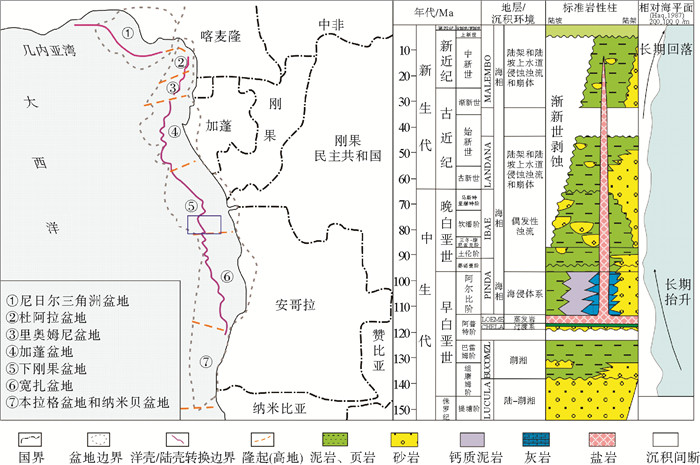Depositional Elements of Deepwater Channels and Their Evolution
-
摘要:
近年来,深水水道已成为油气勘探的重要目标,加强深水水道内部沉积单元以及沉积演化的研究对于深水油气勘探来说至关重要。基于3D地震资料,利用地震属性、地震相等研究下刚果盆地深水水道的内部沉积单元及演化规律。研究表明,研究区深水水道发育底部滞留沉积、水道侧壁滑塌沉积、侧向加积体、堤岸沉积、废弃水道5种沉积单元。深水水道形成于复杂的多期侵蚀-充填过程,纵向演化可划分为水道过路侵蚀、侧向迁移水道、高弯度垂向加积水道、水道堤岸复合体和废弃水道5个阶段,各个阶段水道内充填结构和水道平面展布特征呈现有规律的变化。水道的5个演化阶段是一个水道完整的演化模式,海平面变化、重力流供给、陆坡均衡剖面等共同控制着深水水道的演化。
Abstract:Deepwater channel deposits have been a kind of significant exploration target in recent oil and gas exploration. To study the depositional elements of the deepwater channels and their evolution has, therefore, become an important task for geologists. In this paper, deepwater channel elements of the Lower Congo Basin were selected as cases for study, based on seismic attribute maps and seismic facies analysis from 3D seismic data. The integrated analysis reveals that channels filling deposits consist of five elements, including basal lag deposits, slump deposits, LAP, levee deposits, and abandoned channels from bottom up. Each channel suffered an evolution of five stages, i.e. channel incision, lateral amalgamation, aggradation, levee deposition and abandonment with time. The evolution of channels is controlled by sea-level fluctuation, development of gravity flow and slope equilibrium.
-
Key words:
- deepwater channel /
- gravity flow /
- sedimentary elements /
- levees /
- evolution stage /
- Lower Congo Basin
-

-
[1] Deptuck M E, Steffens G S, Barton M, et al. Architecture and evolution of upper fan channel-belts on the Niger Delta slope and in the Arabian Sea [J]. Marine and Petroleum Geology, 2003, 20(6): 649-676. http://www.wanfangdata.com.cn/details/detail.do?_type=perio&id=1dd9c649a5e41347ad04b12027b7b465
[2] Gong C, Wang Y, Zhu W, et al. The Central Submarine Canyon in the Qiongdongnan Basin, northwestern South China Sea: architecture, sequence stratigraphy, and depositional processes [J]. Marine and Petroleum Geology, 2011, 28(9): 1690-1702. doi: 10.1016/j.marpetgeo.2011.06.005
[3] Kolla V, Bourges P, Urruty J M, et al. Evolution of deep-water Tertiary sinuous channels offshore Angola (west Africa) and implications for reservoir architecture [J]. AAPG Bulletin, 2001, 85(8): 1373-1405. http://www.wanfangdata.com.cn/details/detail.do?_type=perio&id=ebdcb3a132fb5eec5a0bcf66aa3b9c45
[4] Posamentier H W, Kolla V. Seismic geomorphology and stratigraphy of depositional elements in deep-water settings [J]. Journal of Sedimentary Research, 2003, 73(3): 367-388. doi: 10.1306/111302730367
[5] Nakajima T, Peakall J, McCaffrey W D, et al. Outer-bank bars: a new intra-channel architectural element within sinuous submarine slope channels [J]. Journal of Sedimentary Research, 2009, 79(12): 872-886. doi: 10.2110/jsr.2009.094
[6] Cross N E, Cunningham A, Cook R J, et al. Three-dimensional seismic geomorphology of a deep-water slope-channel system: The Sequoia field, offshore west Nile Delta, Egypt [J]. AAPG Bulletin, 2009, 93(8): 1063-1086. doi: 10.1306/05040908101
[7] Wynn R B, Cronin B T, Peakall J. Sinuous deep-water channels: Genesis, geometry and architecture[J]. Marine and Petroleum Geology, 2007, 24(6): 341-387. http://d.old.wanfangdata.com.cn/NSTLQK/NSTL_QKJJ025118388/
[8] 李磊, 王英民, 张莲美, 等.尼日尔三角洲下陆坡限定性重力流沉积过程及响应[J].中国科学(地球科学), 2010, 40(11): 1591-1597. http://www.wanfangdata.com.cn/details/detail.do?_type=perio&id=zgkx-cd201011013
[9] Abreu V, Sullivan M, Pirmez C, et al. Lateral accretion packages (LAPs): an important reservoir element in deep water sinuous channels [J]. Marine and Petroleum Geology, 2003, 20(6): 631-648. http://d.old.wanfangdata.com.cn/NSTLQK/NSTL_QKJJ026879953/
[10] Armitage D A, Romans B W, Covault J A, et al. The influence of mass-transport-deposit surface topography on the evolution of turbidite architecture: the Sierra Contreras, Tres Pasos formation (Cretaceous), southern Chile [J]. Journal of Sedimentary Research, 2009, 79(5): 287-301. doi: 10.2110/jsr.2009.035
[11] Skene K I, Piper D J W, Hill P S. Quantitative analysis of variations in depositional sequence thickness from submarine channel levees [J]. Sedimentology, 2002, 49(6): 1411-1430. doi: 10.1046/j.1365-3091.2002.00506.x
[12] Cross N E, Cunningham A, Cook R J, et al. Three-dimensional seismic geomorphology of a deep-water slope-channel system: The Sequoia field, offshore west Nile Delta, Egypt [J]. AAPG Bulletin, 2009, 93(8): 1063-1086. doi: 10.1306/05040908101
[13] Dykstra M, Kneller B. Lateral accretion in a deep-marine channel complex: implications for channellized flow processes in turbidity currents [J]. Sedimentology, 2009, 56(5): 1411-1432. doi: 10.1111/j.1365-3091.2008.01040.x
[14] Mayall M, Jones E, Casey M. Turbidite channel reservoirs—key elements in facies prediction and effective development [J]. Marine and Petroleum Geology, 2006, 23(8): 821-841. doi: 10.1016/j.marpetgeo.2006.08.001
[15] 刘祚冬, 李江海.西非被动大陆边缘盆地盐构造对油气的控制作用[J].石油勘探与开发, 2011, 38(2): 196-202. http://d.old.wanfangdata.com.cn/Periodical/syktykf201102010
[16] 李冬.琼东南盆地中央峡谷深水天然堤——溢岸沉积[J].沉积学报, 2011, 29(4):689-694. http://www.cqvip.com/QK/95994X/201104/38847742.html
[17] Arnott R W C. Stratal architecture and origin of lateral accretion deposits (LADs) and conterminuous inner-bank levee deposits in a base-of-slope sinuous channel, lower Isaac Formation (Neoproterozoic), East-Central British Columbia, Canada [J]. Marine and Petroleum Geology, 2007, 24(6): 515-528. http://www.wanfangdata.com.cn/details/detail.do?_type=perio&id=fbc69e7827fbb0c1c031bebfa8736b15
[18] Deptuck M E, Sylvester Z, Pirmez C, et al. Migration-aggradation history and 3-D seismic geomorphology of submarine channels in the Pleistocene Benin-major Canyon, western Niger Delta slope [J]. Marine and Petroleum Geology, 2007, 24(6): 406-433. http://www.wanfangdata.com.cn/details/detail.do?_type=perio&id=c0e5170c2911a7264e51eba67ebf7797
[19] Hickson T A, Lowe D R. Facies architecture of a submarine fan channel-levee complex: the Juniper Ridge Conglomerate, Coalinga, California [J]. Sedimentology, 2002, 49(2): 335-362. doi: 10.1046/j.1365-3091.2002.00447.x
[20] 李华, 何幼斌, 王振奇.深水高弯度水道—堤岸沉积体系形态及特征[J].古地理学报, 2011, 13(2): 139-149. http://d.old.wanfangdata.com.cn/Periodical/gdlxb201102002
[21] Prather B E. Controls on reservoir distribution, architecture and stratigraphic trapping in slope settings [J]. Marine and Petroleum Geology, 2003, 20(6): 529-545. http://www.wanfangdata.com.cn/details/detail.do?_type=perio&id=3110a14f1eb57d42cca544173aaf33d5
[22] Kane I A, Hodgson D M. Sedimentological criteria to differentiate submarine channel levee subenvironments: exhumed examples from the Rosario Fm.(Upper Cretaceous) of Baja California, Mexico, and the Fort Brown Fm.(Permian), Karoo basin, S. Africa [J]. Marine and Petroleum Geology, 2011, 28(3): 807-823. doi: 10.1016/j.marpetgeo.2010.05.009
[23] Hodgson D M. Distribution and origin of hybrid beds in sand-rich submarine fans of the Tanqua depocentre, Karoo Basin, South Africa [J]. Marine and Petroleum Geology, 2009, 26(10): 1940-1956. doi: 10.1016/j.marpetgeo.2009.02.011
[24] Peakall J, McCaffrey B, Kneller B. A process model for the evolution, morphology, and architecture of sinuous submarine channels [J]. Journal of Sedimentary Research, 2000, 70(3): 434-448. doi: 10.1306/2DC4091C-0E47-11D7-8643000102C1865D
[25] Kneller B. The influence of flow parameters on turbidite slope channel architecture[J]. Marine and Petroleum Geology, 2003, 20(6): 901-910. http://www.wanfangdata.com.cn/details/detail.do?_type=perio&id=504e246dcd832b419f84d185824ec2ed
[26] Samuel A, Kneller B, Raslan S, et al. Prolific deep-marine slope channels of the Nile Delta, Egypt [J]. AAPG bulletin, 2003, 87(4): 541-560. doi: 10.1306/1105021094
[27] Janocko M, Nemec W, Henriksen S, et al. The diversity of deep-water sinuous channel belts and slope valley-fill complexes[J]. Marine and Petroleum Geology, 2013, 41:7-34. doi: 10.1016/j.marpetgeo.2012.06.012
-




 下载:
下载:



